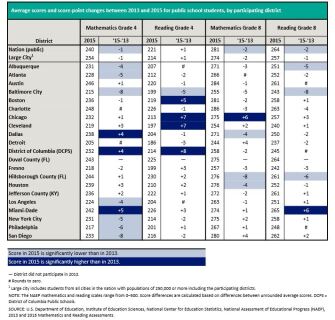This post was originally published on High School & Beyond.
The 2015 scores from the National Assessment of Educational Progress are out, and there isn’t much good news at the national or state levels from our 8th graders. But there are a few promising tidbits from the big cities at both the 4th and 8th-grade levels.
The bottom line: Since 2013, math scores have declined in both 4th and 8th grades. Reading scores are unchanged in 4th grade since 2013, but declined in 8th. My colleague Liana Heitin explores the national picture of 4th and 8th grade results on the Curriculum Matters blog. And you can review the 2015 results on NAEP’s site here, too.
But let’s look a little bit more closely at our 8th graders. Nationally, they lost 2 points on their reading scores, and 2 points on their math scores since 2013. On a 500-point scale, this year’s scores were 282 in math and 265 in reading. Only one-third of our 8th grade students performed at the “proficient” level or higher in either subject.
It doesn’t get any prettier if you look at the NAEP state-level results. In the chart below, see those dark blue bars? They indicate a statistically significant improvement in scores since 2013. The 4th grade columns are sprinkled with dark blue bars—maybe not as many as we’d like to see, sure, but still—while the 8th grade columns show only one state with that kind of score improvement. And it’s only in one subject.

A couple of big-city districts turned in some strong improvements in 8th grade, however. Chicago produced a 6-point gain in math, and Miami-Dade County produced a 6-point gain in reading. There are a few 3- and 4-point gains in the mix, but they didn’t reach the level of being statistically significant. Here’s how the rest of the districts that participate in NAEP’s big-city-testing program performed:

If you look at 8th grade performance by percent proficient, rather than by scale score, you can see that a few districts outstripped the nation in general. Austin, Texas, Charlotte, N.C., and Boston produced greater percentages of students scoring at or above proficient in 8th grade math than did the nation overall, and San Diego performed on par with the national proficiency rate in math (32 percent).
Reading didn’t produce such strong results. Not a single district outpaced the national average in reading (33 percent proficient or higher). But Austin and Charlotte came in at that same level.
As Liana’s story conveys, many of those who spun today’s results are suggesting that the dip could be influenced in part by the transitions most states are making to common-core curricula. Based on what you’re seeing in your classrooms and districts, is this a reasonable interpretation?



